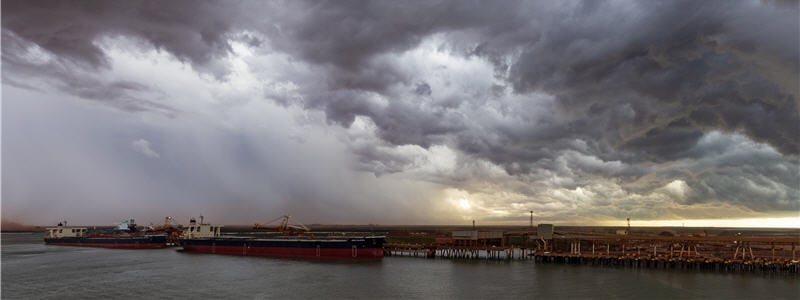In the nickel ore regions of Indonesia and the Philippines, the rainy season starts in June and lasts until November. The September-October typhoon season in the Philippines is of particular concern. Skuld is monitoring entered vessels that load nickel ore in the region, and we see an increase of rain affected cargo.
Nickel ore liquefaction – recent Skuld experience
We recently had a nickel ore liquefication issue on an entered vessel. She loaded nickel ore in the Philippines and two days later cargo liquefication occurred when facing a tropical storm. The Master reported that the cargo in holds number 1 and 2 had liquefied, and the depth of the liquefication was about 70cm from the cargo surface. The cargo in holds number 3 and 4 had slid to the portside and the vessel was listing about 7 degrees to port.
The Master had taken immediate actions by adjusting the course and speed and correcting ballasting to better stabilise the vessel. Luckily the weather improved, and the vessel could proceed to her discharge port where she safely arrived on 5 August 2019.
MV "Nur Allya" – Vessel and 25 crew missing
Members may already know that the 52,000 dwt, Panama-flagged, Nur Allya has been missing since 20 August when she was underway along the northern coast of Buru Island. A major search operation involving air and sea assets has regrettably found no sign of the missing vessel or crew.
Urgent warning from INTERCARGO
INTERCARGO is once again urging shipowners, operators and crew to exercise extreme caution when loading nickel ore and other cargoes that have the potential to liquefy. The warning comes in the wake of the disappearance of the above-mentioned vessel.
Recommendations
Members and masters are advised to take extreme caution when loading nickel ore in the region of Indonesia and the Philippines.
The following actions are recommended:
- The compulsory notification requirements set out by the P&I clubs must be complied with prior to arriving at the load port, and a preloading survey is highly recommended.
- Always obtain the required cargo documentation from the shippers in advance (Shippers Cargo Declaration, TML & MC certificates) so that it can be checked.
- Ensure that all safety precautions outlined in the IMSBC Code are followed.
- The cargo and loading should be closely monitored and well controlled by a Can Test and any wet cargo must be rejected.
- The passage of the vessel to her discharging port should be well assessed and planned to minimise motions of the vessel (e.g. rolling and pitching etc.). Heavy weather (e.g. wind force BF 7 or above) should be avoided.
- Ensure that your C/Ps have BIMCO Charterparty clauses for solid bulk cargoes that can liquify.
- If the weather permits, check the condition of the cargo in the holds daily and notify your club immediately if anything abnormal is found.
The above is not a comprehensive outline on liquefaction and we refer to previous circulars on skuld.com, including the one dated 21 June 2018.
